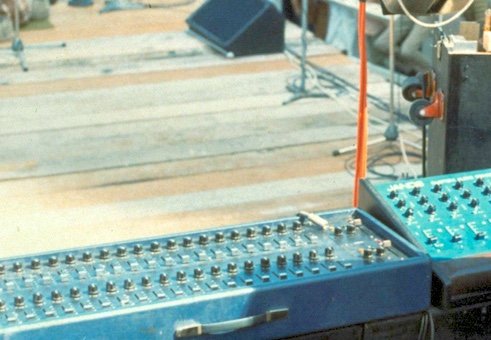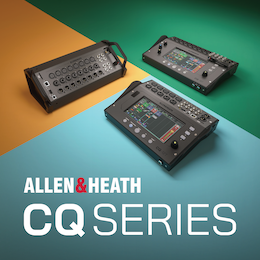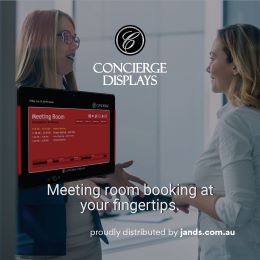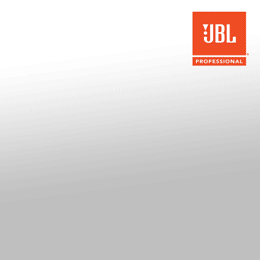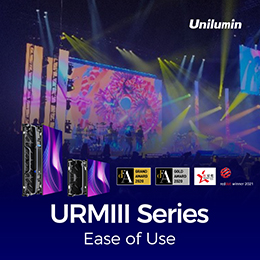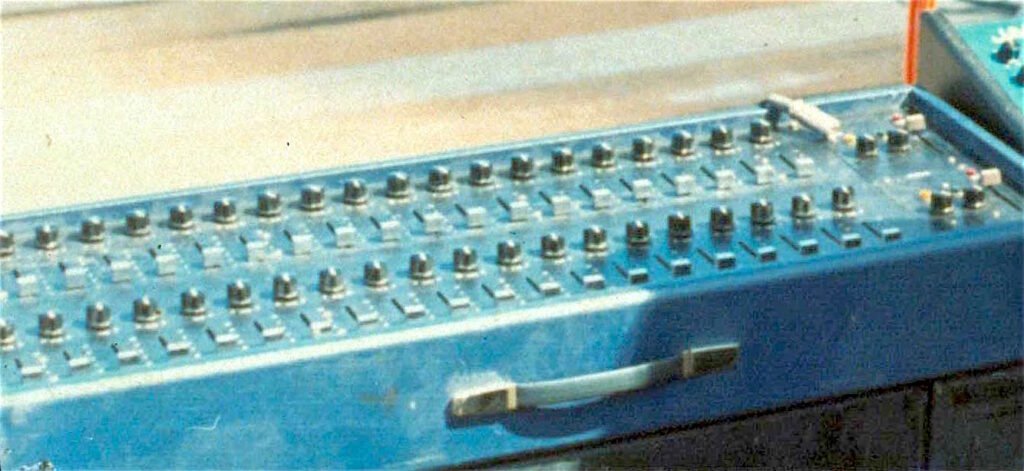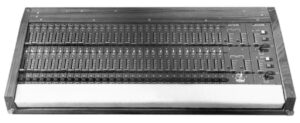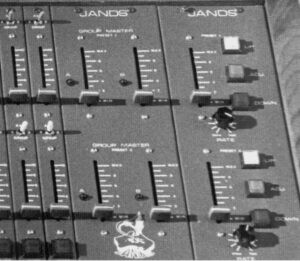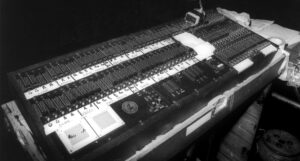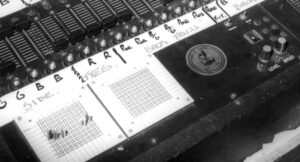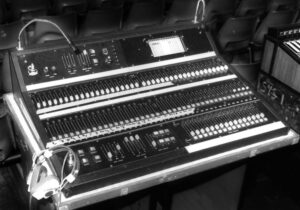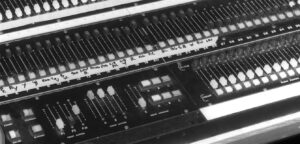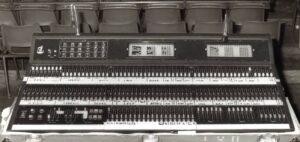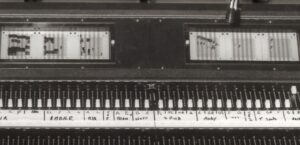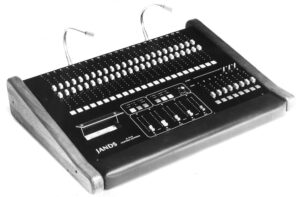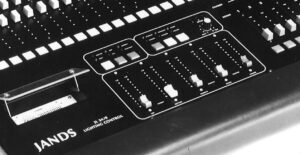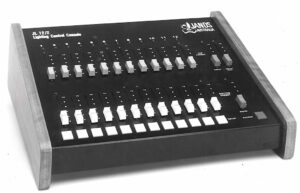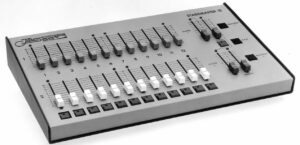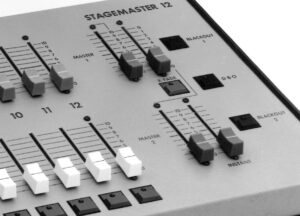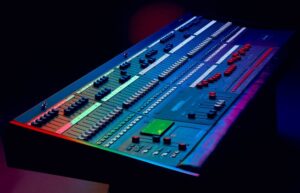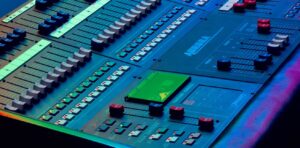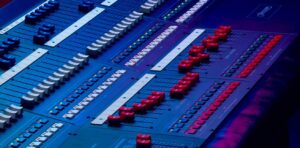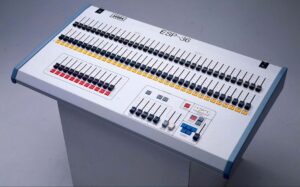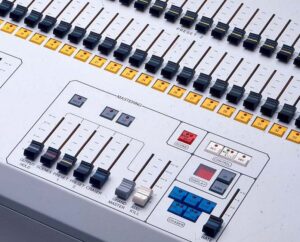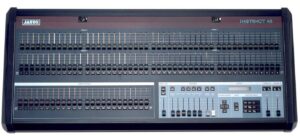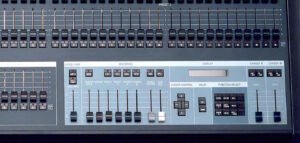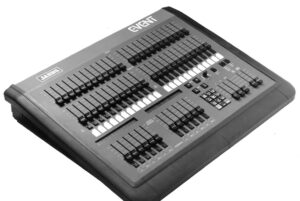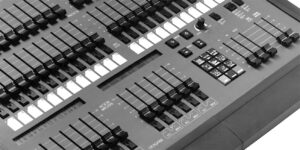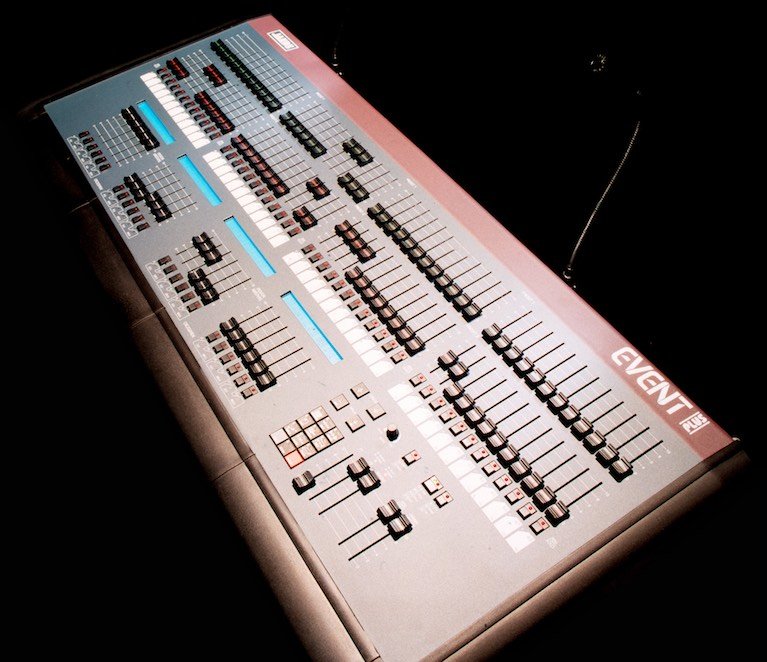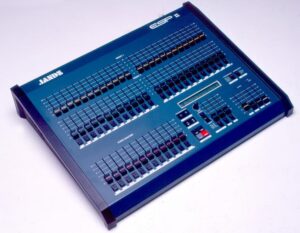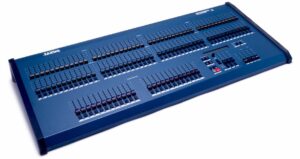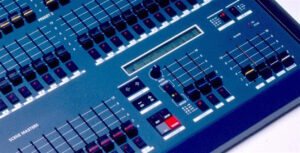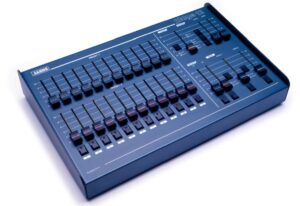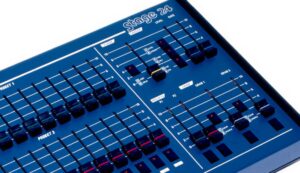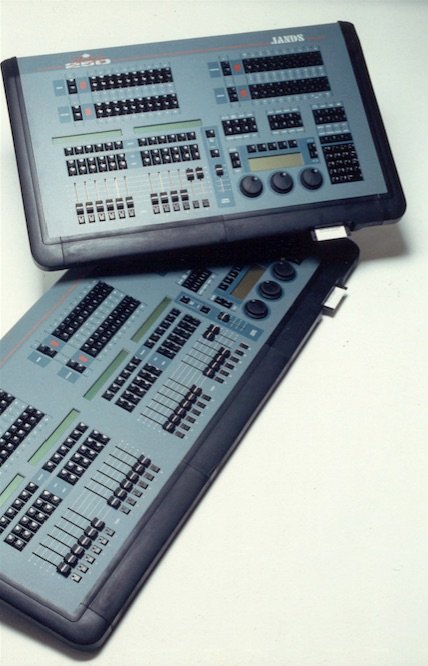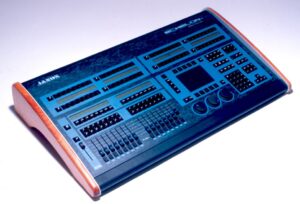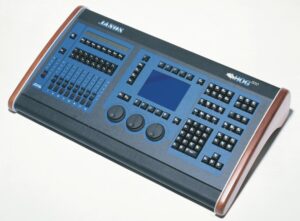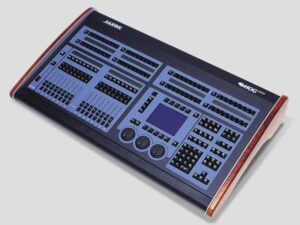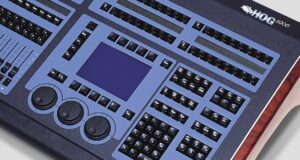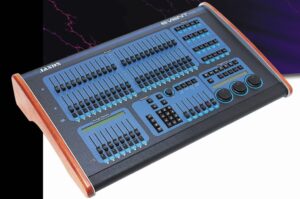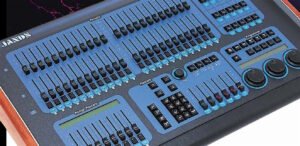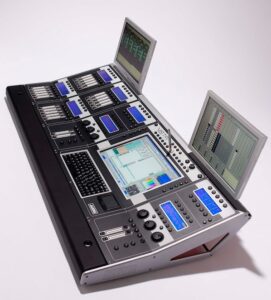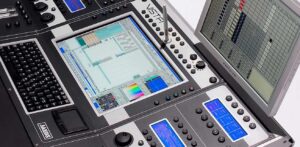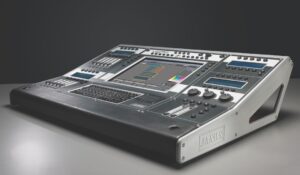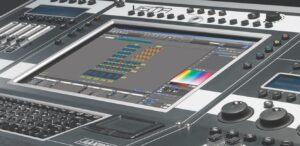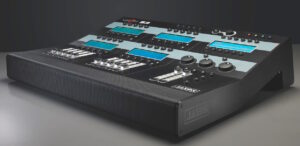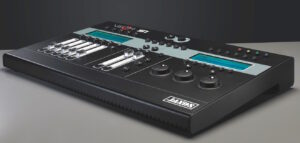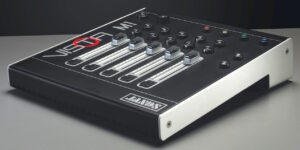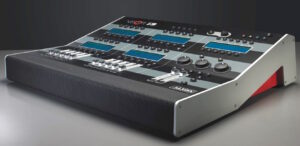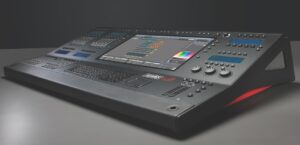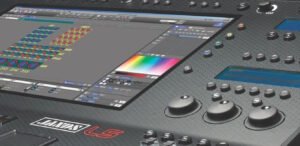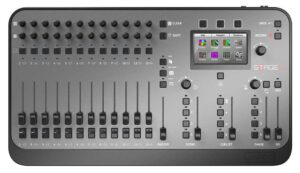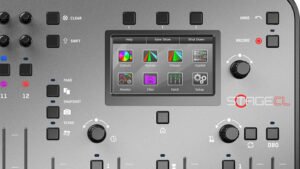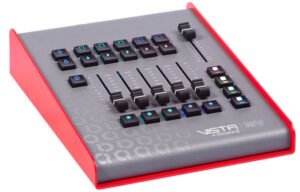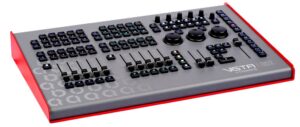Subscribe to CX E-News
HISTORY
47 Years of Jands Lighting Control – A history of products from 1971 until 2018
by Julius Grafton.
Since 1971, there’s been non-stop research and development of new lighting consoles by JANDS in Sydney.
“In the early seventies, most concerts were in the daytime”, says JANDS director David Mulholland. “We were doing sound, but for the Led Zeppelin concert at Randwick Racecourse we were asked to supply some fresnels in open white to fill out any shadows on the stage”.
Soon the need for concert lighting control arrived, in an era where the only dimmer boards available were designed for theatre and made by Strand Electric. Typically, these had two or three presets and not much more. Ironically JANDS had won a contract to make the circuit boards for Strand dimmers, which at the time were made in racks of 10 channels.
Enter the JANDS JL1, for want of a better name.
“Our first console had 2 presets, 20 channels, 45mm sliders, A/B switches, but no flash buttons”, David continues. Next came the JL2, with 60mm faders, A, A+B, B mastering and 30 channels. These early manual preset boards were connected by thick analogue multicores to the dimmers, which required one wire per channel to send the + or – 10v DC control signal.
- JL2
- JL2 control
“By the mid-seventies we started to see control boards by Electrosonics and Alderham with matrix patching for scenes and chases. By inserting a special diode pin into the patch panel, you could assign any of the control channels to one or more of the scene or chase masters. This inspired our JL3, which featured 48 channels, 2 presets, 16 scene masters and a high density matrix board manufactured by Ghielmetti Switzerland.”
The JL3 also included a flash button on each channel and a Chaser, with a thumbwheel to set the number of channels in the chase – up to 8 steps, and switches for forward, backwards or shadow chase, which was all on, one off.
The next iteration was the JL4, again with 16 matrix masters, but the matrix panel was at the top right. This was to keep the fragile pins out of the way as they could break and be jammed in the panel. Subsequently the JL5 was built with 60 channels, 20 Scene Matrix masters and 3 x 6 channel chasers with their own masters and matrix.
- JL3
- JL3 close
- JL4
- JL4 control
- JL5
- JL5 close
Up until then these consoles were built specifically for JANDS Concert Productions. There was a wide gap in the market, with many rental firms modifying Strand Miniset and SP preset boards with matrix sections and flash buttons. The Strand product was expensive.
In 1980 JANDS launched the JL24/8 as a commercially available console. “The prototype was painted brown, (the colour of our lighting cases in those days) and sold to Billy McCartney who was working in Thailand and needed a console for a tour by the Osmonds that year,” David recalls.
The JL24/8 had 8 matrix masters, with the last 3 switchable to a chaser. The matrix panel was safely set low with a hinged perspex cover. It was a runaway success, followed shortly after by the JL36/12. These became the standard lighting consoles across the booming suburban touring market that exploded in the early 1980s.
There were literally hundreds of bands and touring production trucks on the road, most with a JL console in the back. Soon after the JL12/2 followed, a real ‘bread and butter’ 12 channel console for smaller shows and schools. These units, later named as the StageMaster, sold in large numbers for many years.
- JL24/8
- JL24/8 close
- JL12/2
- Stagemaster 12
- Stagemaster 12 control
The Memory Board Arrives
JANDS had in 1982 purchased Rock Industries, whose founder Richard White was deep into research for a memory console. These had revolutionised theatre and TV in the mid 1970s, with insanely expensive systems like the Strand System DDM which offered immediate memory recall and magnetic tape storage.
Richard’s research led to the JANDS Aurora, in 48 or 60 channels. It had 24 scene masters and could store 192 scenes and 22 chase sequences with up to 48 steps. The Aurora was in design from early 1984 and the first production console was shipped in December of that year.
- Aurora
- Aurora control
- Aurora scene
Jands Production Services used Auroras on a number or tours including Tears for Fears 1985 shows where 2 consoles were slaved together and Jands long-time head of manufacturing, Terry Cooney, was enlisted as tour tech. JANDS Lighting lead designer David Timmins takes up the story:
“The Aurora used a Z80 processor on a commercial STD-bus motherboard. It worked reasonably well, but we were breaking new ground and it was prone to the odd crash. But the main problem was that when it crashed, all the channels would fade up to full.
“That was usually bad since back then many shows did not provision enough mains for all the dimmers to be running at 100% and the main breaker would trip. Finding a popped circuit breaker in a venue can be tricky in the middle of a show!”
“Our manufacturing records show that JANDS built 45 Auroras and released 3 software versions.”
Richard White moved on from JANDS and today is one of Australia’s most successful software vendors, heading Wisetech Global. He also returned to JANDS in 2016, buying a significant non-controlling shareholding.
JANDS CEO Paul Mulholland had visions for selling overseas. Lighting technology was moving fast, and DMX 512 had arrived, allowing simple lightweight cabling from control desk to dimmers and the new moving lights that were arriving commercially.
Prior to the widespread use of DMX rental systems like Vari*Lite, Pan Command had produced dedicated moving light control consoles with proprietary cable systems and control protocols.
In 1988 JANDS introduced the ESP, in 24, 36 and soon 48 channels. It had 12 scene masters, and rudimentary memory presets so you would set the chase and the pages using a compact 2 digit display.
- ESP 36
- ESP close
It sold well in Australia, the US, and the UK, and was in production up until 1992. And of course, it had a DMX output.
“That DMX output caused a few problems of its own” recalls David Timmins. “I remember doing a show at the Kardomah Café in Kings Cross with a prototype ESP and having the DMX UART crash on me – it was spitting out rubbish making all the channels continuously flash.
“Lucky I had a backup and operated the rest of the show from side of stage using an old analogue console”. Production versions were fixed with a higher spec part and that problem never resurfaced.
An increasing number of dimmers were being used, and with the advent of scrollers and then multi-parameter moving lights, the race has been on for more control channels. Today’s top end consoles can easily handle 18,000 or more.
In mid 1989 JANDS launched the Instinct which started with 48, then 60, and later 72 channels. David Timmins: “The hardware was designed to do up to 72 channels with 864 scenes and 36 chases. We had a 24 character by 2 line LCD screen, and you set the chase, scene page and other parameters in there.
“It also had a softpatch and an offline editor. It was very sophisticated for the time.” “It sold very well in Japan; they had a real thing about channels and they loved the 72 model.
“A bit of trivia – as part of the service routine, the Japanese service techs would replace every fader once a year. We had no idea at the onset how long the faders would last, but they changed them all!”
Next Steps
In early 1990 work started on the EVENT, based on the 68,000 Motorola 32-bit processor as used in early Mac computers.
“We had months of weekly meetings over the specification, figuring out how the automation would work. With that document ready we then had two hardware and two software engineers working for over a year to make it reality.”
Launched in February 1991 with 24, 36, and 48 channels, the Event range was very successful, with the last one built in September 2010. “Events were really clean inside, one 20 way bus around all the cards, one power supply, one processor card. They were easy to put together and pretty reliable.
- Event 24ch
- Event 24 close
“With Event we released around 15 software versions in total that included bug fixes and feature updates. Features like wide mode, where the two presets could be used as one for double the channel count, and user definable pages were unique at the time.”
Event used a 32 x 2 LCD module, which was uncommon and caused supply problems later on when it became obsolete.
“We had to custom tool a replacement module which wasn’t cheap,” David adds. JANDS added a number of option modules, including a memory card, video output, Socopex analogue output, and later a floppy disk drive – easy to do since the console hardware had been designed with add-in module spaces on the back panel.
The Event Plus built on Event success and was released in 1992 with 48, 60, or 72 channel versions. With extra scenes and more processor power from a 68030, and an uprated power supply, it was also a success and well liked in film work.
With Event established, JANDS turned to updating the ESP. A new model was based on Event hardware with the same or similar cards and the same core software but released as the ESP 2. In 24, 48, or 60 channels, the ESP 2 also did wide mode and could be linked to an Event console. Production of the ESP2 ceased in 2010.
- ESP II 24
- ESP II 36
- ESP II close
A baby console to replace the ubiquitous JL12/2 followed. The Stage 12/24 was based an Event preset card but had no show storage. It did feature temporary ‘grab’ scenes and a chase function.
- Stage 12
- Stage 24
- Stage 24 close
Behind the scenes a deal was being made that would make world news. Flying Pig Systems were riding high on the success of the Wholehog console that had revolutionised moving light control and were working on its successor. Codenamed TNT (The Next Thing) the Wholehog 2 was to have all new software and hardware.
JANDS and Flying Pig Systems reached an agreement to collaborate on the development of an economical moving light console that would extend the reach of the Hog software. It was agreed that the Wholehog 2 and JANDS Hog consoles should share the same code base, and work on the JANDS Hog began.
In mid 1995 JANDS unveiled the JANDS Hog 250. It was a dedicated moving light controller, separating all the intensity, position, colour, gobo and beam parameters and providing 250 channels. The JANDS Hog 600 followed soon after.
David Mulholland: “We had thought a lot about a moving light console and it wasn’t far from where the Pigs wanted to go. The Wholehog II software formed the basis for the 250 and the 600.”
By the late 90s, console effects were becoming a key selling point, and for this the processor in the JANDS Hog was not up to the task, so work commenced on a replacement. In 1998 the Echelon was released with a new “ColdFire” processor, updated displays, and 1024 channels.
Like its predecessors it ran software by Flying Pig Systems and included an effects engine for the first time. In 1999 High End Systems bought out Flying Pig Systems. The Echelon was rebadged as the Hog 1000 and the family extended to include a smaller Hog 500 console. Both were successful worldwide and were still being made in 2009.
- Echelon
- Hog 500
- Hog 1000
- Hog 1000 close
“The writing was on the wall”, said David. Meanwhile the Event IV family was released in 1999, using the same processor as the Echelon. The Event4 grafted a moving light section on to a traditional 2 preset fader board. The 408 had 8 scene masters while the 416 had 16 scene masters.
- Event 408
- Event 408 close
High Stakes: Vista
“In 2000 we moved off on our own to come up with a moving light console that would change the world of lighting,” said David Mulholland. “It was a three-year development process. The T Series Vista was shown in October 2003 at PLASA.
“Dave Harding did a demo at the show, on the hour, showing the timeline and the GUI (Graphic User Interface) and it created an amazing reaction.”
“Vista was about visualising the timing of event transitions, so you could see and manipulate when a fixture would fade in, change position and so on rather than punching in long sequences of numbers on a keypad.
“We had an R&D grant from the Australian Government to develop the software – our pitch for the grant included a demo showing a group of lights fading up and changing position in a timed sequence. To build the cue on a regular console it took around 60 key presses, then we showed how on Vista you just clicked, selected and dragged in the timeline and it was done.”
The Vista T4 first shipped in March 2004 with 4 DMX outputs standard and a capacity of up to 8,192 channels. Then came the smaller T2 with less playbacks, but with the same channel capability. Both had a top of the line Wacom pen tablet built in.
- Vista T4
- T4 close
- Vista T2
- Vista T2 close
The S3 followed; a control surface that connected via USB and used your laptop for the brains and display. You could buy a licensing dongle for however many channels you needed – unlocking 128 to 16,384 channels.
“Vista’s strong point was that it was scalable. At the time we were the only people doing that”, David said.
E2 was an extender for the T2, adding more playbacks. S1 was an even more basic control surface. 5 playbacks, multi pages, programming sections. M1 was a simple playback surface. I3 is an S3 with added brain minus display. D1 offered more than 16 universes.
- Vista S1
- Vista M1
- Vista I3
“In late 2011 a new flagship console, the L5, was released. It was the last of the really big surfaces with a 22” Wacom full HD tablet, industrial motherboard, and Quadcore Pentium processor.
“It replaced the T2 and T4. Possibly we misread the market; the screen cost us over $2,000 and that made it a very expensive console.”
- Vista L5
- L5 close
In 2012 JANDS released the Stage CL – which almost turned full circle back to a fader per channel. JANDS continue to sell this console in large quantities.
“It did something unique, it is easy to use. It has Vista software scaled down, and a touch screen interface” says David Timmins.
- Stage CL
- Stage CL detail
Sale To Chroma-Q
Software development continues on; new versions, adding features and bug fixes. In the current version 2 software build is 18,361 – that’s the number of times one of the software engineers has committed some kind of change to the Vista code!
“Software development is never ending. We had 5 software engineers, working mainly on Vista, for over 10 years and that’s only recently dropped under 4. We have been working on version 3 for over two years.
“This version includes customisable workspaces, improved multi-element fixture visualisation, effects masters and a much-expanded command line interface
“There are 2 USB consoles that have just been announced by Chroma-Q, we developed the EX as a cost-effective replacement for the S1, it has double the number of playbacks, 5 extra encoders and 12 function button and then there’s the MV which replaces the M1.”
- Vista MV
- Vista EX
“We had scoped out an L5 replacement but meeting the market’s price expectations is tough.”
“So now we provide the software engineers under a service contract to Chroma-Q. They plan to expand the team and bring new engineers on board in Canada.
“We’re very proud of Vista, and we would like to see it have continued success in someone else’s hands. Chroma-Q have a fine reputation for hardware manufacture and we are confident the product has an exciting future in their hands.”
With this comes the end of nearly half a century of lighting control development by JANDS.
From the December 2018 – January 2019 edition of CX Magazine. CX Magazine is Australia and New Zealand’s only publication dedicated to entertainment technology news and issues – available in print and online. Read all editions for free or search our archive www.cxnetwork.com.au
© CX Media
Subscribe
Published monthly since 1991, our famous AV industry magazine is free for download or pay for print. Subscribers also receive CX News, our free weekly email with the latest industry news and jobs.


